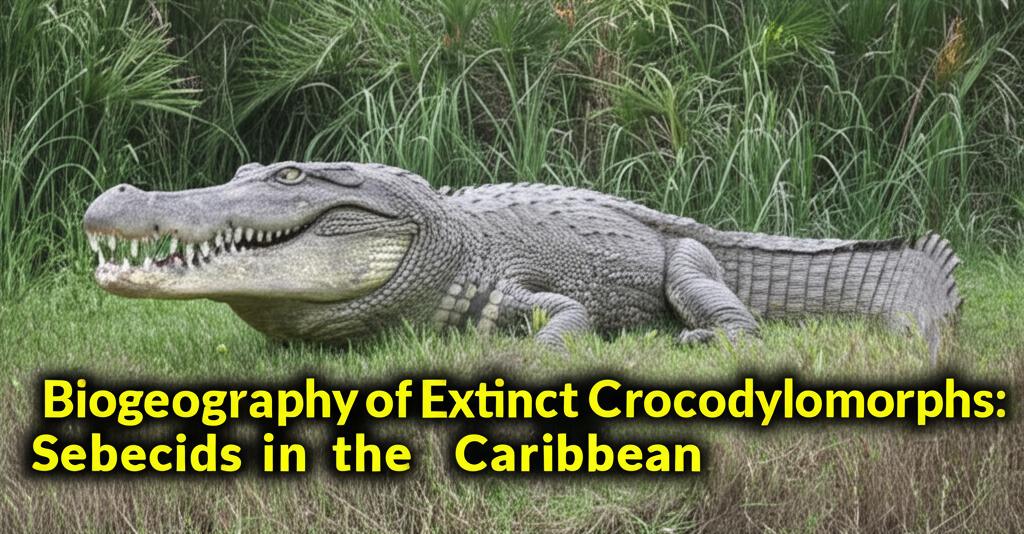Recent fossil discoveries are rewriting the ecological history of the Caribbean, revealing that large, land-dwelling crocodylomorphs called sebecids roamed these islands much longer than previously understood. These findings challenge long-held assumptions that such apex predators never inhabited the region and offer new insights into their biogeography and eventual extinction.
Sebecids, a group of extinct crocodylomorphs, were distinct from their modern crocodile relatives. Built more like greyhounds, they stood tall on relatively long limbs positioned directly under their bodies, adaptations for terrestrial life. Some species could reach impressive lengths of up to 20 feet and possessed armor-like bony plates embedded in their skin. Their skulls were tall and narrow, similar to carnivorous theropod dinosaurs, and their teeth were notably tapered, laterally compressed, and serrated – perfectly designed for slicing through flesh. These formidable predators dominated the South American landscape after the extinction of the non-avian dinosaurs, thriving for tens of millions of years. Until recently, paleontologists believed they vanished from the fossil record around 11 million years ago.
However, a series of intriguing fossil finds in the Caribbean began to complicate this narrative. Over three decades ago, two unusual, serrated teeth dating back approximately 18 million years were discovered in Cuba. Another tooth, even older at 29 million years, later surfaced in Puerto Rico. While these isolated teeth hinted at the presence of a significant terrestrial predator, they weren't sufficient to definitively identify the animals as sebecids, as other crocodylomorph groups also possessed similar dental features.
The breakthrough came in early 2023 when a research team unearthed another fossilized tooth in the Dominican Republic, crucially accompanied by two vertebrae. Though a modest find, the characteristics of these vertebrae, particularly their flattened structure (unlike the ball-and-socket joints of other crocodile relatives), provided the key evidence. These fossils, dated to be between roughly 4 and 7 million years old, confirmed the presence of sebecids in the Caribbean. This discovery is significant not only as the first confirmed record of sebecids in the Caribbean but also because it suggests these predators survived here at least 5 million years after they were thought to have gone extinct on mainland South America. The Caribbean, therefore, may have served as a final refuge for these remarkable reptiles.
The presence of these terrestrial predators in the Caribbean raises fascinating questions about their dispersal. The open sea separating the islands from mainland South America would have posed a significant barrier for animals adapted to life on land. This has led researchers to revisited the GAARlandia (Greater Antilles-Aves Ridge land bridge) hypothesis. This theory proposes that temporary land bridges or a chain of islands once connected South America to the Caribbean, facilitating the movement of terrestrial fauna. The discovery of sebecids on multiple islands, if the teeth from Cuba and Puerto Rico also belong to this group, lends further support to this idea. An alternative, though perhaps less likely for predominantly terrestrial animals, is dispersal by rafting on large mats of vegetation.
The sebecids found in the Caribbean were the last known surviving members of Notosuchia, a diverse and ancient group of crocodylomorphs with a fossil record stretching back to the age of dinosaurs. Notosuchians exhibited a wide array of sizes, diets, and habitats, with most being terrestrial. The Dominican Republic sebecid is estimated to have been about two meters long, although other sebecid species, like Barinasuchus from South America, could reach lengths of up to 10 meters.
The eventual extinction of sebecids in the Caribbean, perhaps occurring by the time some island bird species evolved flightlessness, would have significantly altered the island ecosystems. In their absence, smaller endemic predators like birds, snakes, and other crocodile relatives likely evolved to fill the vacated ecological niches.
These recent discoveries underscore the dynamic nature of prehistoric Caribbean ecosystems, which were evidently more complex and harbored large apex predators for a more extended period than previously envisioned. Further paleontological exploration in the Caribbean, particularly in older geological deposits beyond caves and blue holes (which tend to preserve younger fossils), promises to unveil more secrets about the region's ancient life and the remarkable story of sebecid survival.

